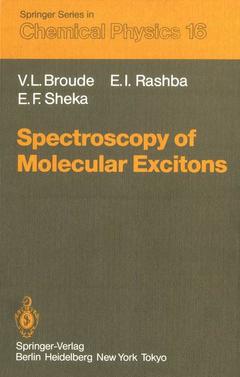Description
Spectroscopy of Molecular Excitons, Softcover reprint of the original 1st ed. 1985
Coll. Springer Series in Chemical Physics, Vol. 16
Authors: Broude Vladimir L., Rashba Emmanuel I., Sheka Elena F.
Language: French
Subject for Spectroscopy of Molecular Excitons:
Keywords
52.74 €
In Print (Delivery period: 15 days).
Add to cart
Publication date: 04-2012
274 p. · 15.5x23.5 cm · Paperback
274 p. · 15.5x23.5 cm · Paperback
Description
/li>Contents
/li>
Low-temperature spectroscopy of organic molecular crystals came into being in the late 20s, just when quantum physics of solids as a whole began to de velop vigorously. Already in the early works, two experimental facts of prime importance were discovered: the presence of a multitude of narrow bands in the low-temperature spectrum of a crystal, and a close relationship between the spectrum of the crystal and that of the constituent molecules. These findings immediately preceded the celebrated paper of Frenkel in which he went beyond the framework of Bloch's scheme and advanced the exciton concept. Subsequent investigations showed that the most interesting features of the spectra of molecular crystals are associated with excitons, and then the spectroscopy of molecular excitons began to form gradually on the basis of the spectroscopy of organic crystals. The molecular exciton became synonymous to the Frenkel exciton in a molecular crystal. In view of the difficulties involved in the analysis of rich spectra con taining many tens of bands, the spectroscopy of molecular crystals had long been connected most closely with the spectroscopy of molecules. It had deve loped independently, to a large extent, from the other branches of solid state physics. This was also emphasized by the difference in experimental techniques, the specific properties of the objects, etc. As a result, there was some lag in ideas and concepts.
1. Experimental Background.- 1.1 Molecular Crystals.- 1.2 Electronic Spectra of Molecules.- 1.3 Comparing the Electronic Spectrum of a Crystal and That of a Molecule.- 1.4 Isotopic Effect in Electronic Spectra.- 1.5 Spectra of Doped Crystals.- 1.6 Electronic Spectra of Crystals and the Spectroscopy of Molecular Excitons.- 2. Exciton Spectra of Perfect Crystals.- 2.1 Molecular Excitons.- 2.2 Wave Functions and the Energy Spectrum of Excitons.- 2.3 Exciton Green’s Function.- 2.4 Conductivity Tensor of a Crystal.- 2.5 Exciton Bands of Molecular Crystals.- 3. Exciton Spectra of Doped Crystals.- 3.1 Imperfect Crystal s.- 3.2 The Theory of the Absorption of Light by Local Excitons: Isotopic Impurities.- 3.3 Exciton Spectra of an Isotopic Impurity.- 3.4 The Exciton Spectra of Aggregates of Isotopic Guest Molecules in IDC.- 3.5 Exciton Spectra of Defect Centres.- 4. Exciton Spectra of Mixed Crystals.- 4.1 Energy Spectra of Mixed Crystals.- 4.2 Average-Amplitude Approximation.- 4.3 Mixed Crystals of d-Naphthalenes. The Genesis of Exciton Bands.- 4.4 Methods of Calculating Mixed-Crystal Spectra.- 4.5 Mixed-Crystal Spectra. A Comparison of Theory with Experiment.- 4.6 Migration of Excitons and Localization of Exciton States in Mixed Crystals.- 5. Band-to-Band Transition Spectra.- 5.1 Classification of Vibronic Spectra.- 5.2 Band-to-Band Transitions in Perfect Crystals.- 5.3 Band-to-Band Spectra of Mixed Crystals.- 6. Vibronic Spectra of Molecular Crystals.- 6.1 Exciton-Phonon Interaction.- 6.2 Dynamical Theory of Vibronic Spectra.- 6.3 Vibronic Absorption Spectra of the Solid Aromatic Compounds.- 6.4 A Quantitative Interpretation of the Vibronic Spectra of Crystals Based on the Dynamical Theory.- 6.5 Vibronic Spectra of Imperfect Crystals.- Conclusion.- Appendix A IntramolecularVibronic Interaction in Terms of the Secondary-Quantization Representation.- Appendix B Theory of Degenerate Perturbations.- References.
© 2024 LAVOISIER S.A.S.
These books may interest you

Excitonic Processes in Solids 52.74 €



